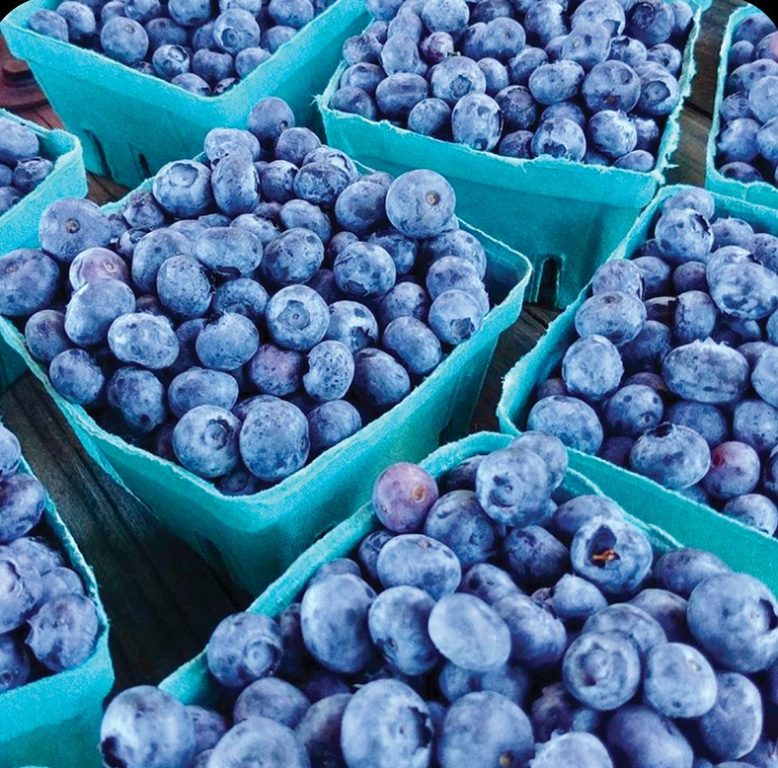
Anthony DiMeo III is a fourth-generation blueberry grower in Hammonton. His great-grandfather purchased DiMeo Farm’s original blueberry bushes 105 years ago from Elizabeth Coleman White, the New Jersey woman who cultivated the world’s first commercially viable blueberry.
Now the enterprise that has sustained generations of DiMeo’s family could be in jeopardy. Climate scientists and environmentalists say the industry that was born in the acidic, sandy soil of the Pinelands could die there as well.
“We are definitely concerned and want to learn what blueberry farmers like us can do, if anything, to prevent that from happening,” says DiMeo.
Blueberries have grown into big business in the Garden State. A USDA report indicates that 9,300 New Jersey acres yielded 46 million pounds of blueberries in 2019, valued at more than $85 million.
The luscious little berries also pack a cultural wallop. While there are three naturally occurring species in New Jersey, the most common, the highbush blueberry—named the state’s official fruit in 2004—is a backbone of the Pinelands lifestyle.
Now, climate change threatens both the Jersey blueberry and the region where it grows.
“If we don’t change what we are doing now, we will see mass impacts like the disappearance of core parts of our identity, like the Jersey blueberry and the Pinelands,” says Doug O’Malley, director of the nonprofit Environment New Jersey Research and Policy Center. The Jersey blueberry, he adds, could be gone by 2050. “The fate of our beloved Jersey blueberries is in peril.”
Coleman White, the daughter of a prominent Burlington County cranberry farmer, created New Jersey’s highbush blueberry (Vaccinium corymbosum) in an effort with the USDA to craft the perfect blueberry. Almost two decades after Coleman White started her work, the USDA reported 150 acres in New Jersey were dedicated to the crop. By the time she died in 1954, there were 5,000, a figure that has since nearly doubled.
Though commercial varieties that yield more berries per acre have been introduced to New Jersey farms, some local growers—like DiMeo—still produce the heirloom varieties based on Coleman White’s original. “It’s a continuation of our family heritage and traditions,” says DiMeo.
Blueberries thrive in the unique soil of the Pinelands, which occupy 1.1 million acres in the southern portion of the state, making it the largest preserved area between Boston and Washington, D.C.
“It’s barren land from the perspective of land use,” says Carlos Martinez Rivera, the director of conservation science at Pinelands Preservation Alliance. “You can’t grow much on it, but that means what does grow on it is highly adapted to survive in this soil.” He adds that the plants and animals native to the Pinelands are vastly diverse, and it’s their unique, delicate equilibrium that makes them especially vulnerable to climate change.
Devastating effects are already being seen in another iconic native of the Pinelands: the Atlantic white cedar. The tree is dependent on the 17 trillion-gallon freshwater aquifer underneath the Pinelands, but rising sea levels have caused saltwater intrusion. The trees are absorbing the salty water and dying, leaving behind patches of “ghost forests” of white, bare trunks.
For blueberries, there’s been evidence of an earlier growing season, which threatens crops. “When blueberries go into bloom early, they become more susceptible to frost and freeze in early spring,” says DiMeo.
Warmer temperatures during the winter can be just as harmful to blueberries. “Their growing season depends on cold snaps,” says O’Malley. “The lack of cold snaps would prevent blueberries from being able to flower and develop fruit.”
Climate change could also cause more variable water supplies. There might be periods of drought, increasing the threat of forest fires in the already vulnerable Pinelands, as well as flooding from rising ocean waters. But more frequent, severe storms might be an even greater threat, says Rutgers agricultural agent Gary Pavlis. “If you’ve got a lot of rain, the fruit will swell up with water and cause cracking,” says Pavlis. “It also decreases the flavor and quality of the berry.”
[RELATED: Love the Jersey Shore? Help Protect It This Summer]
Storms could also prevent farmers from being able to harvest the berries in time or make conditions too muddy for mechanical harvesters, which have become critical to farming as available workers have dwindled. Wetter periods could also lead to problems with fungus growing on the berries.
While states like Michigan and Maine have been dealing with climate change’s effects on their blueberry crops for years, New Jersey is just beginning to record it, says Martinez Rivera. “A lot of things we see occur, we can attribute to climate change,” he says, adding that a report released by the state Department of Environmental Protection last year opened people’s eyes. The report made it clear that New Jersey might no longer be suitable for specialty crops like the blueberry and cranberry.
The devastation would be cultural as well as economic. Blueberries are a way of life, and their growing season is cause for celebration every year, as people come together for large public gatherings like the Red, White and Blueberry Festival in Hammonton, the self-proclaimed blueberry capital of the world, with more than 56 farms dedicated to the crop.
“It’s in our roots,” says John Runfolo, executive director of the Greater Hammonton Chamber of Commerce, who has organized the event since 1987. “It’s fostered a lot of pride in the area.”
Scientists in New Jersey and across the country are working on breeding blueberries adapted to climate change. “There will still be blueberries in the store,” says Martinez Rivera, “but it’s uncertain whether they will be Jersey blueberries.” He added that farmers will face a lot of uncertainties, and some are not going to be able to afford to purchase new, adapted varieties or make other changes necessary to keep up with a warmer, wetter climate.
Despite the harrowing news, there is hope of saving the Jersey blueberry. “If people pay attention to changes and projections, and if people act before things really happen, of course you can prevent tragedies,” says Martinez Rivera.
The best way to slow down climate change, says O’Malley, is reducing the use of fossil fuels that are known to cause it. “We need to move toward clean, renewable [energy] sources,” he says. He adds that a lot depends on government policy and commends the Murphy administration for making strides toward a greener, cleaner state. Still, he says, there is more work to be done.
“This is not to say the blueberry is doomed,” says O’Malley. “It is to say if we continue on our current path, we will live in a massively different world.”
